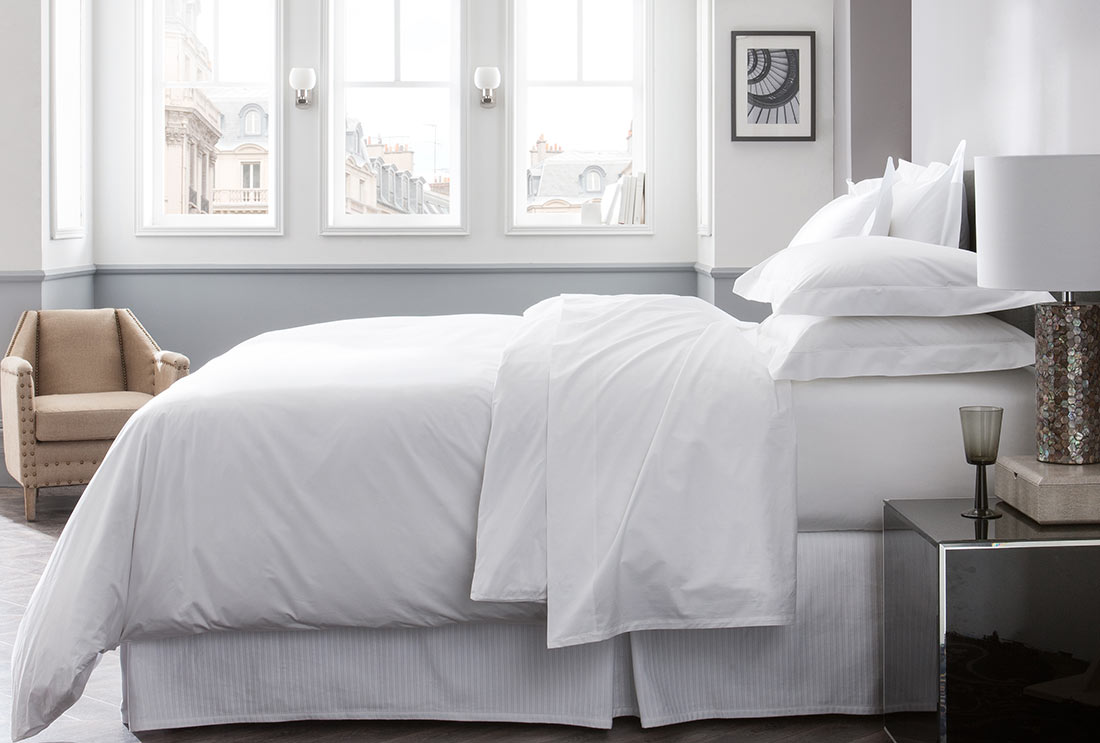
La différence entre le satin et le satin. Et qu’est-ce que le satin en ce qui concerne les draps ?
Avez-vous déjà acheté de nouveaux draps, pour ensuite vous retrouver coincé entre les options étiquetées « satin » et « satin » ? C'est un peu déroutant, non ? Certains pourraient même penser qu’il s’agit d’une erreur d’impression. Les deux tissus se ressemblent beaucoup. Ils se sentent très similaires. Alors, cela soulève la question : quelle est la différence entre le satin et le satin ?
Tout est dans le tissage
La première réaction de beaucoup de gens est que ces deux noms à consonance similaire font référence à la fibre réelle utilisée dans le tissu. Bien qu'ils utilisent des fibres différentes, le satin et le satin ne sont pas réellement des fibres en soi : ils constituent un style de tissage. Ou du moins, ils l’étaient…
Traditionnellement, le tissu était (et est toujours) créé en tissant des fibres selon la méthode « une sur une sur l'autre ». Fils égaux de chaque côté du tissu. C'est pourquoi, hormis les coutures, vos t-shirts en coton ont la même apparence à l'intérieur qu'à l'extérieur. Le tissu du t-shirt en coton est uniformément équilibré.
Lorsque le satin a pris son essor au Moyen Âge, il était fabriqué à partir de fils de soie selon un style spécial « quatre sur, un sous ». Le résultat? Le côté à quatre fils était incroyablement doux et arborait une brillance luxueuse, tandis que l’autre côté était beaucoup plus sourd et terne. C'est pourquoi le satin a un côté résolument « droit » du tissu, ce qui signifie que si vous retournez une chemise en satin, vous verrez une différence notable de l'autre côté.
Finalement, ce tissage de style satin a été adapté au fil de coton, et le tissu résultant (qui partage des caractéristiques similaires au satin) a été surnommé – vous l’aurez deviné – Sateen.
Aujourd’hui, le satin a de nombreuses significations
Comme mentionné, le satin était traditionnellement tissé à partir de fils de soie fins. Le seul problème est que la soie peut être incroyablement chère. Ainsi, lorsque les styles en satin ont pris leur essor sur tout, des vestes et robes aux ballerines et draps de l'ère Disco, les fabricants ont dû trouver un moyen de réduire les coûts.
Entrez les tissus synthétiques…
Les fabricants ont appris qu'ils pouvaient obtenir un aspect et une sensation (quelque peu) similaires aux tissus traditionnels en satin de soie en les remplaçant par des tissus synthétiques tels que le polyester. À mesure que la popularité du « look satiné » continuait de croître, l’utilisation de ces matières synthétiques augmentait également.
Aujourd’hui, il y a tellement de satin synthétique sur le marché que le terme « satin » est devenu, au mieux, alambiqué. Le plus souvent, les produits étiquetés « satin » sont en réalité un tissu à base de polyester conçu pour ressembler aux tissages traditionnels de soie satinée. Cela signifie qu'à moins de lire réellement l'étiquette ou de comprendre quand, où et comment ce morceau de tissu a été fabriqué, vous ne saurez peut-être même pas à quoi vous avez affaire.
Maintenant, le revers de la médaille est le satin. Étant donné que le satin est fabriqué à partir de fils 100 % coton, il est facile de savoir à quoi vous avez affaire. C'est du coton, tout le temps.
Quel est le meilleur?
Bien qu’il n’y ait pas de véritable « meilleur » dans le cas du satin et du satin, les différences dans la fibre sous-jacente peuvent rendre l’une beaucoup plus adaptée que l’autre dans certains cas.
Le satin est souvent utilisé dans les vêtements, des chaussures de ballet aux vestes de baseball. L'éclat du satin en fait le moyen idéal pour créer des pièces que vous souhaitez vraiment mettre en valeur. Mais cet éclat a un prix, car le satin est beaucoup moins durable que ses homologues en satin. Étant donné que la plupart des satins modernes sont fabriqués à partir de fibres synthétiques, les vêtements et les draps en satin sont beaucoup plus sujets à l'usure et ne peuvent souvent pas être lavés en machine, ce qui signifie que tout doit être nettoyé à la main. Ils nécessitent également plus d’entretien et ont une durée de vie plus courte en raison de cette durabilité limitée.
Le satin, quant à lui, présente une brillance lumineuse similaire et une douceur incroyable comme le satin, mais avec tous les avantages sous-jacents du coton – le tissu le plus naturel au monde. Avec une base en coton, le tissu satiné est beaucoup plus durable et durera beaucoup plus longtemps que le satin – avec l'avantage supplémentaire d'être le plus souvent lavable en machine. C’est pourquoi, pour des articles tels que les draps, le satin est clairement le gagnant.
Une dernière différence notable entre les deux réside dans le traitement des tissus. Comme tout matériau en coton, le satin peut être traité avec un minimum de traitements et de produits chimiques (cela est particulièrement vrai pour les produits en satin fabriqués à partir de coton biologique). La soie, en revanche, est un peu plus difficile à traiter et assez laborieuse à traiter et à teindre. C’est pourquoi les produits en satin sont souvent plus chers que les produits en satin similaires.
Cela a du sens, mais revenons à mes draps…
Comme vous l'avez peut-être deviné, en raison de sa durabilité supérieure, de sa facilité d'entretien et de son traitement minimal lors du traitement, White Terry Home est un fan du tissage satiné en matière de draps. Cela signifie que nos draps ont un tissage satiné, mais sont entièrement en coton, extrêmement respirants et régulent la température. Plus d’informations sur pourquoi dans notre prochain article de blog.
J'espère que cela vous aidera à résoudre le mystère du satin contre le satin. La prochaine fois que vous achèterez des draps, des ballerines ou tout autre objet intermédiaire, n'oubliez pas ces différences entre les deux. Bien qu’ils puissent souvent sembler presque identiques, il se passe beaucoup de choses sous la surface qui peuvent et doivent affecter votre choix de tissu.
Vous avez encore des questions ? N'hésitez pas à cliquer sur le bouton « Envoyez-nous un message » ci-dessous et nous serons heureux de vous fournir toutes les réponses dont vous avez besoin !



